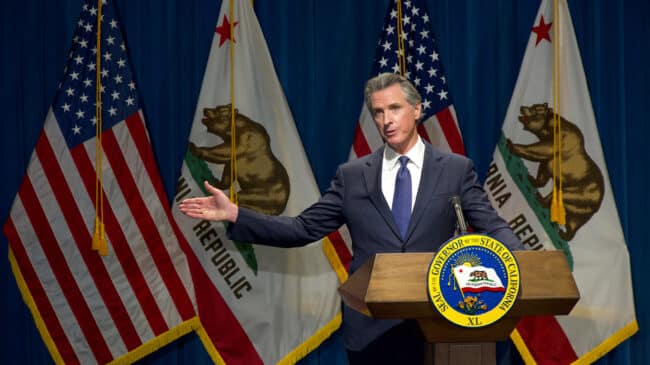California Gov. Gavin Newsom recently released his 2024-2025 budget proposal, which included $76.2 billion in state general fund revenue for K-12 public schools. Facing what he claims is a projected $37.9 billion budget deficit in the state general fund—an optimistic estimate—Newsom’s administration confronted some tough choices on where to trim spending to balance the state budget, such as whether to stick to previous commitments to expanding community schools and transitional kindergarten.
Unfortunately, instead of finding ways to improve efficiency, address declining enrollment and reduce spending on K-12 education, which is the state’s single-largest budget item and accounts for more than one-third of the general fund, Gov. Newsom resorted to creative accounting and rosy economic forecasts to push his public school priorities.
The governor wants to ignore declining student enrollment in public schools and unsustainable education spending projected to cause future state budget deficits.
It took almost every tool at Gov. Newsom’s disposal to shelter public schools from spending cuts. First, the administration projected a far lower budget deficit than the $68 billion the state Legislative Analyst’s Office (LAO) estimated. So he could claim fewer budget cuts are needed, Gov. Newsom’s budget proposal banks on an economic and tax revenue bounce back that is $15 billion higher than LAO’s forecast.
Next, the governor proposed budget cuts, payment deferrals, and cost shifts in areas outside K-12 education, such as housing, climate programs, and higher education. Lastly, Gov. Newsom proposed using more than $13 billion of the state’s $24 billion in reserves to cover the rest of the deficit, including $7 billion in reserves for K-12 education.
As the Legislative Analyst Office’s December report makes clear, dipping deep into reserves is unsustainable because the agency forecasts ongoing budget deficits of about $30 billion annually from 2025-2026 through 2027-2028. This far exceeds what the state has in reserves. Notably, LAO outlines a pathway to sustainably balancing the budget by reducing state education funding by $16.7 billion—which California could implement without hurting students and still comply with the constitutionally mandated share of the state budget that has to be spent on education under Proposition 98.
As severe as a $16.7 billion budget cut sounds, LAO’s suggested education cut would include community colleges and universities, not just K-12 schools, and it would be spread over three fiscal years spanning from the 2022-2023 budget year to 2024-2025. These retroactive cuts would acknowledge past overpayments that would need to be taken out of future payments.
California public schools have also lost more than five percent of their K-12 population, 310,000 students, from late 2019 through the 2022-2023 school year. Over two-thirds of the state’s school districts are dealing with declining enrollment and empty school buildings. The Public Policy Institute of California projects the state to face further enrollment losses through 2031.
At the same time, California’s per-student funding would grow to an all-time high of $23,519 per student under Gov. Newsom’s proposal. That would be an increase of 35 percent since the start of the COVID-19 pandemic. According to the latest U.S. Census Bureau data, California was already ranked 15th in the nation with per-pupil funding of $19,512 in the 2020-2021 school year.
It’s worth noting Gov. Newsom isn’t protecting core school operations with the new budget proposal. Instead, he’s trying to preserve spending that reaches far beyond the scope of a traditional K-12 education, such as continuing the expansion of transitional kindergarten, universal pre-K, and community schools, which are public schools that also offer “wraparound services” such as counseling, health care, and food assistance. Despite poor student outcomes and standard classrooms emptying, Newsom continues pushing for the state’s struggling public education system to be even more all-encompassing.
There are a few notable bright spots in Newsom’s budget. It would ease barriers to entry for new teachers by recognizing bachelor’s degrees as meeting basic skills requirements to earn a teaching credential and give school districts additional flexibility to have schools open on Saturdays to address learning loss stemming from chronic absenteeism.
As budget negotiations with the legislature proceed, Gov. Newsom and lawmakers should prioritize K-12 spending on core programs that can improve student outcomes, not the expansive list of pet projects that don’t help students and can’t be justified with the massive deficit.
A version of this column first appeared in the Los Angeles Daily News.

